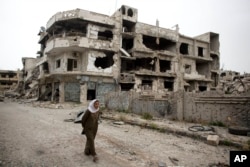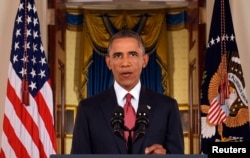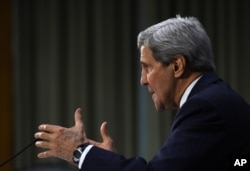Another year has passed in Syria, with no end in sight for a conflict that has claimed 200,000 lives, injured a million and displaced nearly half the population.
In four years, the Obama administration has sought an effective strategy on Syria, to no avail.
But in November elections, Republicans gained control of the Senate, and some analysts suggest that in next year’s session, Congress could push for the U.S. to take a more aggressive stance against Islamist militants and the regime of Bashar al-Assad.
2014: A turning point
Two rounds of peace talks at the start of 2014 ended without agreement, and the spring saw the Syrian regime regain two key rebel strongholds, Yabroud and Homs.
Syrian President Bashar Al-Assad announced elections June 3, which he won - predictably - by a landslide. That same month, the United Nations announced that it had completed the removal of Syria’s chemical weapons—and the extremist Islamic State group (IS) in Iraq and Syria announced it had established a caliphate.
From this point on, the rebels have been fighting a war on two fronts.
On the one front, Assad’s military carried out 2,000 airstrikes between October 20 and November 29 alone, according to the Syrian Observatory for Human Rights, killing more than 500 Syrians, even as U.S. planes were in Syrian skies.
The regime looks poised, analysts say, to take Syria’s second city, Aleppo, unless the United Nations can achieve a proposed freeze in fighting, which would allow much-needed aid to reach the embattled population and give parties a brief opening for diplomacy.
On the second front, as Republican Senator Marco Rubio of Florida recently cautioned in the Washington Post, is that the Islamic State group now reaches from North Africa through the Middle East, Pakistan and South Asia and into Southeast Asia.
“Mainstream rebel forces are losing battle after battle to ISIS, as well as to the al-Qaida affiliate, Jabhat Al Nusra,” said Shadi Hamid of the Brookings Institution's Center for Middle East Policy. ISIS is another name for the Islamist group.
Valerie Amos, the U.N.’s top relief official, recently told the Security Council that she had “run out of words” to fully explain the “brutality, violence and callous disregard for human life” witnessed in Syria today.
“The parties to the conflict continue to ignore the most basic principles of humanity,” Amos said. “In many parts of Syria the level of violence has worsened, with civilians continuing to pay heavily with loss of life, serious injuries, psychological trauma, ongoing and recurring displacement and massive damage to property and infrastructure.”
Missing the mark?
In September, U.S. President Barack Obama announced a two-fold strategy for degrading and destroying IS in Syria and Iraq.
In Syria, the U.S. and, to a lesser extent, five Arab allies have conducted targeted airstrikes against IS, mostly at Kobani, near the Turkish border.
But the impact of these strikes may be more psychological than anything else, said Northeastern University’s terrorism expert Max Abrams.
“I think our airpower was effective, maybe not in qualitatively degrading the IS, but more importantly in terms of puncturing their aura of invincibility,” he said.
The second component of the strategy - training and arming “moderate” rebels - won’t begin until March 2015. But analysts said it may be difficult to find willing partners to work with the U.S. and to properly vet fighters.
“We’re talking here about $500 million to train about 5,000 fighters,” Hamid said. “When we are talking about a military theater in which there are more than 100,000 fighters from a whole variety of rebel grounds, 5,000 fighters are just a drop in the bucket.”
And what, Hamid asks, will those fighters be doing?
“Based on [Joint Chiefs of Staff chairman] General Martin Dempsey’s comments and the comments of other officials, this seems to be a primarily anti-ISIS fighting force,” he said. “But how do you convince 5,000 fighters to hold their fire against their primary enemy, the Assad regime, and focus just on ISIS?”
If the U.S. wants to gain the trust of the Syrian opposition, Hamid said, it would have to admit it got things wrong and address the issue of the Assad regime itself.
“The longer that Assad is in power, the longer Syria is divided,” said Andrew J. Tabler, senior fellow in the Washington Institute’s Program on Arab Politics.
“And the longer Syria is divided, the longer ISIS has free rein over the country.”
New Congress, new policy?
Mid-term elections held in November saw Republicans win control of the U.S. Senate and that could change the equation, Abrams said.
“There are some real differences between Congressional Democrats and Republicans with respect to how to prosecute the war against the Islamic State,” Abrams said.
“And there are a lot of inconsistencies within the parties, particularly in the Republican party.”
Republican Senator John McCain, a vocal critic of Obama’s Syria policy, will assume the chair of the powerful Armed Services Committee in January. He and fellow Republican Senator Lindsey Graham have also called on the administration to more aggressively “support and empower the Free Syrian Army” by setting up safe zones protected by no-fly zones in Syria.
In addition, they have called for “more boots on the ground, more vigorous strikes, more special forces, further arming the Kurdish peshmerga forces.” And they also share Turkey’s assertion that IS militants cannot be defeated so long as Assad remains in power.
“The wild card is how the Democrats will react,” Tabler said. “And it’s there we see Hillary Clinton, thus far one of the party’s potential candidates in the coming election. She has been saying that she advocated for doing more earlier, that there should have been a more robust program and that Obama missed that window.”
“In general,” said Abrams, “Republicans will be more hawkish. The Democrats want to limit Obama in terms of his ability to use ground forces.”
First things first
But before a new Congress decides what action is taken, it will debate who is entitled to authorize it in the first place.
Obama has said repeatedly that he was justified in ordering airstrikes, invoking the 2001 and 2002 authorizations for the use of military force in Afghanistan and Iraq.
But many Republicans say otherwise, arguing that the constitution stipulates it’s up to lawmakers to decide if the country will go to war, where and for how long.
The Senate Foreign Relations Committee last week approved a measure that would give the president the authority to use military force against IS for up to three years, but would ban ground troops, except in certain prescribed circumstances.
Meanwhile, Senator James Inhofe of Oklahoma, the senior Republican on the Armed Services Committee, has introduced a resolution that would authorize the president to use “all necessary and appropriate force in order to defend the national security of the United States” against IS, come up with a strategy within 15 days, and update Congress every 90 days.
A third resolution under consideration, introduced by Democratic Sen. Bill Nelson, acknowledges the U.S. needs to go after IS in both Iraq and Syria. His bill would allow the president to use “appropriate force” against the Islamists, but would not allow him to deploy ground troops.
Republican U.S. Senator Rand Paul wants more than just an authorization. He wants the U.S. to declare a formal war against IS, sending in ground troops only “as necessary for the protection or rescue of members of the United States Armed Forces or United States citizens from imminent danger” or for limited operations and intelligence gathering.
Tabler, with the Program on Arab Politics, believes Republicans will ultimately pressure Obama into doing more in Syria.
“The problem is that the longer this goes on, and the more that the jihadists take over these swaths of Syria and Iraq where you have tribal and other more moderate forces who feel abandoned by the U.S., the less we have to work with on the ground,” he said.
“I think this war is no longer just about Syria or Iraq or even ISIS. It’s something bigger and much more dangerous.”












